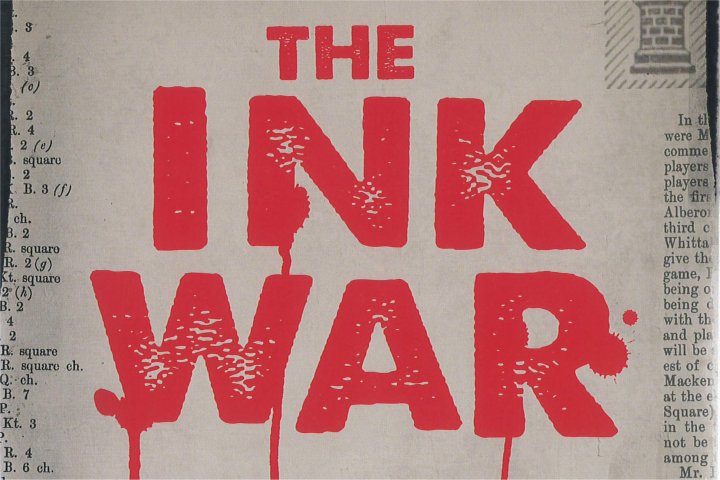Dear Willy Hendriks, you just published your latest book, "The Ink War: Romanticism versus Modernity in Chess". Before we talk about the book, can you tell us something about yourself and your career as a chess player and author?
I started playing chess relatively late, at age 12, and only from about age 35 did chess (playing, writing, coaching) become my main activity. At that age, I became an IM and then achieved two more GM results, but that title will probably remain out of my sight.
Some articles I wrote for a magazine were the prelude to my first book, Move First, Think Later (2012), which was voted book of the year (by the ECF). I developed some of the ideas from that book from a historical perspective in my second book, On the Origin of Good Moves (2020). My recently released third book is an elaboration of a specific episode from that book.
I still play regularly and do some coaching, but writing is my main activity these days and that gives me great satisfaction.
"The Ink War" is about the rivalry between Johannes Zukertort and Wilhelm Steinitz, who in 1886 played the first official World Chess Championship match against each other. When did you first have the idea to write about this rivalry?
For a lecture about On the Origin of Good Moves for the chess club Zukertort Amstelveen a couple of years ago, I decided to focus on the person of Zukertort, who also played a small role in that book, and along the way I found that his rivalry with Steinitz very nicely encompassed the 'birth of modern chess'. At the same time, I got the feeling that that could very well be conveyed as an exciting story; I thought it would be an interesting challenge to get that done.
A lot of chess players know Zukertort only as the loser of the World Championship match against Steinitz. What made you interested in Zukertort, what fascinates you about him and his story?
Ai, now I'm too late with my 'spoiler alert'! Indeed, Zukertort did not become the first world champion, but the tension I wanted to bring into my book lies on slightly different grounds.
Actually, we don't know that much about the person Zukertort, he remains a bit of a mysterious character, partly because he wasn't that forthright and, in addition, he put out quite some fabrications about himself into the world. He is certainly a tragic person, but he plays that role with verve, being the tragic hero of the story. That tragedy lies in several things, including the way he was treated by later historiography: as a representative of romantic chess, which Steinitz overcame. But Zukertort actually wanted to be a modern chess player, which he was. Steinitz had his share in this posthumous character assassination, but I don't want to reveal too much about that here.
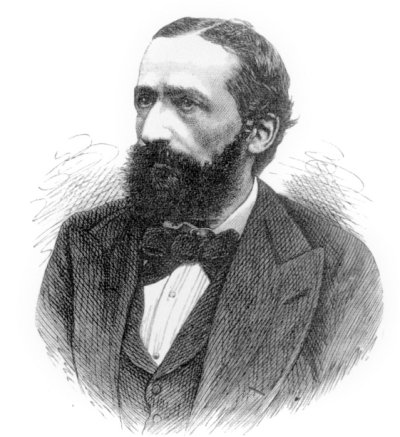
Johannes Hermann Zukertort (1842-1888)
But what interests me most is the conflict and the polemics between my two main characters. A rivalry of two special characters: Steinitz was, if possible, even more stubborn than Zukertort. Add to that all those other special characters who play a role in my story, who were often, on paper at least, at war with each other. And that battle was, in terms of content, also really about something.
How did you find out more about Steinitz and Zukertort and their time? How did you find material for your book, how did you do research?
There is by now quite some literature on that period, contemporary and older, and of course I used it. But most of my research consisted of going through many volumes of chess magazines from that period (most of which are available online) plus replaying very many games from that era. The vast majority of that research (going through magazines) yields nothing but every now and then you stumble upon something that fits beautifully into your story and then my heart springs up.
When you started to work on your book, you obviously knew already a lot about Steinitz and his time. But what surprised you most during your research?
The chess community of those days was already very similar to today's and in a way that is nice to see. Back then, there was much more of a class society than now, but in the world of chess these different groups (with the exception of the large group of the very poorest) happily intermingled, which is quite special.
It is therefore telling that the first World Championship match, played in America, was between two players of Jewish origin from central Europe. Steinitz and Zukertort were not from particularly well-off backgrounds and had to overcome a lot of obstacles to get this far. In many countries, Jews were second-class citizens facing all sorts of restrictions. So that first World Championship match does argue for the tolerant nature of the chess world.
And that still holds true today, everyone is allowed to join us, even those who do not get along so easily elsewhere. Steinitz himself contributed to the image that there are more 'special' types in the chess world than average, although he was not the first to do so (think of Morphy).
"The Ink War" is not only about the rivalry between Steinitz and Zukertort but also about the ideas of Romanticism and Modernism and their role in chess history. Can you briefly describe this conflict?
No, unfortunately that cannot be done 'briefly'! The subtitle Romanticism versus Moderrnity in Chess suggests a black-and-white story, but it is anything but that and I hope I have been able to give a nuanced picture of what (I think) this is all about. In my previous book, I had already noted that the traditional picture of a battle on the chessboard between the romantic attacking school that was overcome by the modern scientific school is not at all accurate and, at least in the games between the stronger players, it is not to be found. But the question that remained was what that romantic movement in chess actually involved, if it had really existed at all. I have tried to answer that question in this book. In that romantic resistance to advancing modernity, all kinds of things played a role, also outside the board. Resistance to professional chess played a major role, and also resistance to the increasingly serious competition (sport). And resistance to a scientific approach to the game.
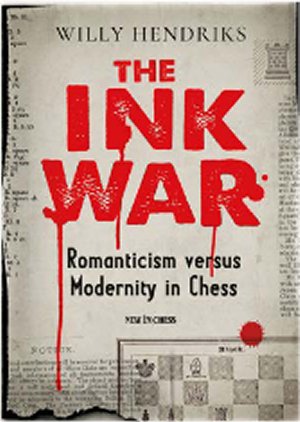
Willy Hendriks, The Ink War, Romanticism versus Modernity in Chess (New In Chess 2022).
This resistance came, among others, from various chess writers, including older gentlemen who played a nice game at their club, and who could hardly understand what exactly was happening in the games of Steinitz and Zukertort and other top players. Steinitz in particular was in constant war with a multitude of opponents in this area but that was partly because he had a great talent for acquiring enemies.
But for the most part, this was a conflict that took place more on paper than on the board.
In "The Ink War" and in your previous book, "On the Origin of Good Moves", you raise doubts whether the traditional and accepted narrative about the development of chess does indeed paint the whole picture, e. g. Anderssen being first of all a bold tactician and foremost exponent of the romantic period, in which according to legend players were only striving for the attack and recklessly sacrificed pieces left, right and centre, while Steinitz was the first player who introduced modern, "scientific" concepts into chess. When did you first have doubts about this narrative?
In Move First, Think Later I discussed the traditional idea that the right way to play chess is to study the characteristics, make a plan on that basis and then search for the right moves that fit in with it.

Willy Hendriks, Move First, Think Later, New in Chess 2012
This method is traditionally attributed to Steinitz, especially by Lasker and Euwe. However, when I went to look at that history, I could hardly find that with Steinitz. Earlier, Cecil Purdy (the Australian correspondence grandmaster and chess author) had pointed this out (in The Great Steinitz Hoax) although, unlike me, he was enthusiastic about that approach. However, he thought it was Lasker's own find, which he had attributed to Steinitz for certain reasons.
When I delved more into that history, it became clear to me that something strange had indeed happened to the lore of Steinitz's ideas and that Lasker, and in his footsteps Euwe, had made something very special out of it.
Of course, Steinitz contributed a lot to our (positional) knowledge. But the famous 'elements of Steinitz' are not to be found with Steinitz and were for the most part already formulated before him (by Staunton, among others). Similarly, the idea of chess as a game of balance that can only be disturbed by mistakes had long been commonplace. The same goes for the principle of accumulation of small advantages. Incidentally, in my view this is more evidence of advancing level than a principle to follow: if opponents get stronger and don't make big mistakes then you can only build up your advantage gradually. In his recently released in-depth book From Stamma to Steinitz, Frank Hoffmeister quotes the Italian writer Del Rio who wrote the following as early as 1802:
'It is very important to guard against certain small disadvantages, which bring others along with them. This piece shut off, castling forfeited, that Knight still not moved out, that enemy Pawn allowed to advance too far, may worsen the position, demand reinforcements on the other side, and little by little turn the battle into a rout. For want of a nail the shoe was lost, for want of a shoe the horse was lost.'
Hoffmeister adds to this that 'as far as I can see, this is the first statement about the "accumulation" of small advantages. We are accustomed to attribute this insight to Steinitz, but it was formulated actually more than half a century previously by Del Rio.' Others, like Von der Lasa and Boden, expressed similar views before Steinitz.
Besides what is wrongly attributed to Steinitz, it is striking that what Steinitz saw as the crown jewel of his 'modern school', a revolutionary new view of the role of the king, is systematically swept under the carpet by Lasker and Euwe. Time and again, Steinitz says it was his most important discovery that the king could play an active role early in the game and that it could defend itself very well. This was also the reason he thought he could push aside the 'old attacking school'. This is questionable to say the least, so it is not surprising that Lasker and Euwe tried to gloss over Steinitz's main principle.
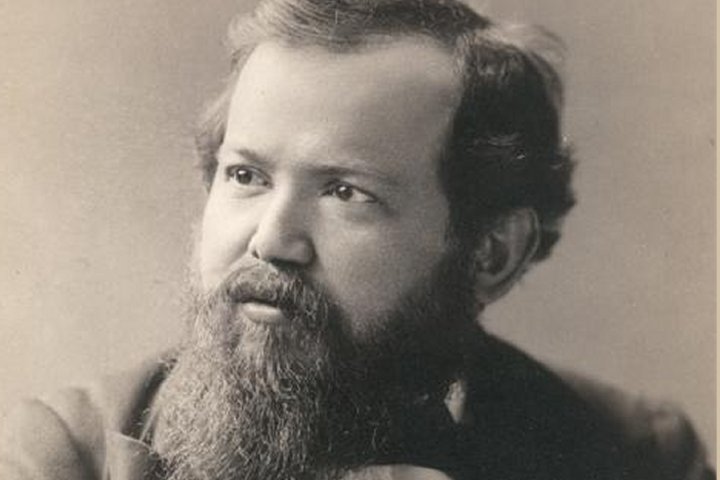
Wilhelm Steinitz | Photo: Austrian National Library
The traditional way of telling and teaching chess history is widespread. When I started to play chess, my first teacher told the story of the development of chess this way, and later I found it repeated in countless books about chess history, from Unzicker/Silbermann’s "Geschichte des Schachs" to Kasparov’s series about his predecessors. And I had never any doubts about this story and told it myself when teaching chess. Do I have to relearn, do chess history books have to be rewritten?
In all modesty: Yes, I think it's good if we leave that old-fashioned story behind and in particular the idea that there is a break in chess history which consists of Steinitz inventing or discovering positional chess and thus dealing the death blow to romantic attacking chess. This so-called break was later even described as a 'Copernican turn', a revolution in our approach to chess. That break did not take place. In my opinion, a more evolutionary view of chess history gives a better understanding of what really happened.
What do you think caused the traditional narrative and why is it so persistent?
I think Lasker is the main culprit here. In my last two books, Lasker is somewhat 'the villain'. Without wishing to detract from Lasker's wonderful chess achievements and all his other merits, I think he has misdirected our image of chess history. For Lasker, Steinitz is the hero, and in his caricature of chess before Steinitz, they just messed around, inspired by the inspiration of the moment. Even though Lasker's rendering is more like a fairy tale than serious historiography, it has been hugely influential.
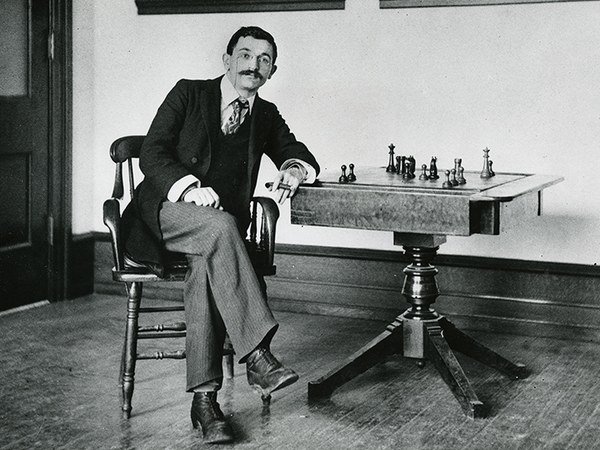
Emanuel Lasker | Photo: Cleveland Public Library
Another factor is that Lasker's (and Euwe's) story has subsequently been rewritten countless times. Each time, the same limited number of games are shown again. For instance, Anderssen's 'immortal game', a cheerful coffeehouse game with indeed a brilliant ending, and one or two other games in the same style. But, for example, his very modern Sicilian victory against Blackburne (Paris 1878) is never shown.
Incidentally, it should be noted that we are in a privileged position these days. With the push of a button, I have all of Anderssen's games on screen, whereas in the past, a historian depended on the books he did or did not have at home, and even then it was an immense task to find and replay those games. That also explains why the same games keep recurring in the manuals. Of course, Anderssen can rightly be proud of those 'romantic' victories that are constantly being re-enacted, but to a certain extent it has been disastrous for his reputation.
How does it feel to discover that your perception of chess history is so different from the accepted way of seeing chess history?
The Ink War is about rivalry and polemic, and I do feel drawn to that. Maybe that is also what attracts me to chess: you make a move, and I will show you why it is wrong! A certain pugnacity is in my character so I can't deny that I take some pleasure in looking at things slightly differently. Incidentally, I see a similarity to Steinitz here, which does make me sympathise with him, even though he was a rare difficult character.
But I am not alone in my view of chess history. In an evolutionary view, progress is not determined by big ideas, new playing styles or by the champion of the moment but much more by small discoveries on a concrete level (bottom-up). Others also write about chess history at this more microscopic level. With those little bits of new chess knowledge, you can think, for example, of a move like Ba3 to hold the black king in the centre. That piece of knowledge has long been commonplace because in the Evans gambit, which was introduced by Captain Evans early in the 19th century, you quickly lose your b-pawn and that's how people came up with that Ba3 idea. A concrete idea going back as far as Greco, in the early 17th century, is that if you have a bishop or knight on g5 and black attacks it with h6, you can sacrifice that piece with h4 to open the h-file. At Greco, by the way, many such pieces of knowledge can be admired for the first time, such as the first rook lift. Yet another idea I researched is the bishop sacrifice on h6. Someone plays that for the first time, it begins to spread and knowledge about all kinds of forms of that sacrifice begins to increase.
Progress in chess, I think, takes place at this more concrete level, and others also write chess history from this evolutionary angle.
But do you think people will indeed relearn and do you think chess history books will be rewritten? I think it was around the beginning of the new millennium when Robert Hübner voiced doubts about the popular belief that Lasker’s success was mainly due to his "psychological play", his ability to understand and exploit the strengths and weaknesses of his opponents. I think Hübner’s arguments are convincing, but a lot of people still seem to prefer the accepted story about Lasker as "psychological player". What do you think will happen to your findings about Greco, Philidor, Steinitz, Zukertort, Anderssen, and other historical players?
I am unfortunately not familiar with that piece by Hübner but I immediately believe he is right. That myth about Lasker's style has always seemed improbable to me because if you can play on complications against one opponent, on simplification against the next, on a kingside attack against a third, and so on, that is only possible if you yourself excel in all areas. Which is therefore a much better 'explanation' for Lasker's successes: he was terribly good at chess!
The kind of explanation Hübner opposes here was very popular throughout chess historiography but surely has its zenith in Richard Réti, who grossed in this kind of caricature. You could describe it as 'essentialism': With Réti, every champion has an essential characteristic that has made him so strong, he is a fighter, a philosopher, a psychologist, a romantic, a fine artist or a representative of American pragmatism. Whereas good chess is not about a single essence but rather about multiplicity. Magnus Carlsen plays chess stronger than me but not because he has one secret. Rather because he has thousands of little secrets. (And the talent to make them his own very easily.)
Quality has its origin in quantity, that evolutionary principle is the unifying idea in my books. In a creationist worldview, multiplicity arises from the genius of a creative principle (top-down). In evolution, complexity arises via the operation of huge numbers from simpler preliminary stages (bottom-up).
So it is with chess understanding. Herman Grooten once told me that the title of his column 'Understanding before Moving' was a pinprick in my direction. Now I grant him that pinprick wholeheartedly, but I still think it works the other way round: It is not the case that moves can be deduced from understanding the position, rather you need to already have the moves at your disposal to understand a position: the more, the better. The question 'how does it stand, what is it about' is inextricably linked to the question 'what works'. That Darwinistic shift in thinking is very difficult for many people to make: our understanding is not the cause but the result of a huge amount of competences. By the way, the chicken-and-egg problem quickly comes around the corner in these kinds of issues.
Anyway, I think I am digressing a bit! To return to the question: I suspect that thinking in essentialist caricatures is pretty persistent, but we keep trying our best. Quality (expertise) does not rest on an essences, but on big numbers. This is of course very well seen in the way the computer plays chess but that is also the underlying mechanism of human chess, even if it goes against many people's feelings.
"The Ink War" contains detailed and careful analyses of all games of the Zukertort – Steinitz match and games Steinitz and Zukertort played in tournaments and matches. What fascinates you about these games?
I look at those games from the theme of my book: who put forward what positional ideas, who was the best competitive chess player, who calculated most accurately, how did they manage their thinking time, and so on. Both saw themselves as modern chess players. Steinitz expressed himself most forcefully about this, 'the modern school, that's me', was more or less his point of view. But Zukertort also saw himself as a modern chess player, or as someone who had reconciled the old attacking and modern positional school. From that perspective, I look at their games. What is then striking is that in their World Championship match, the handed-down cliché image of the romantic attacker versus the modern positional chess player cannot be recognised at all. In fact, it is striking that Steinitz in particular seems to be the stronger at the tactical level, with better variations in general. I suspect Steinitz was the stronger player anyway, but surely he was the stronger competitive chess player. A major theme in my book is the emergence of competitive chess, the transition from the coffeehouse to the tournament arena. On that front, Steinitz was a forerunner while it seems Zukertort had a harder time breaking away from the (fast) coffeehouse chess he had grown up with.
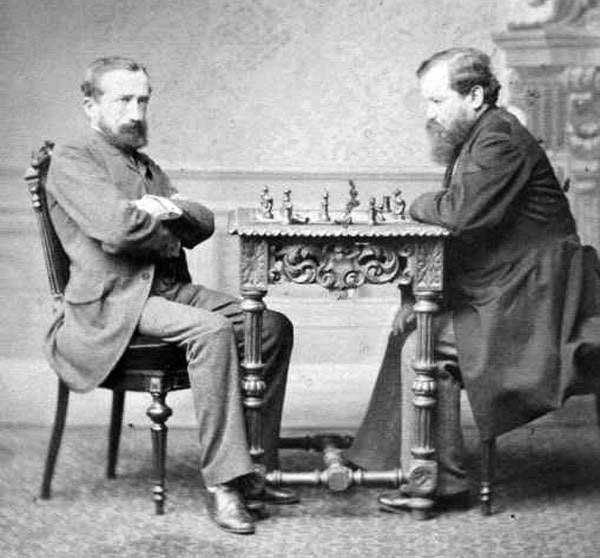
Zukertort (left) and Steinitz during the first official match for the World Championship
Most books about the classics cite a canon of well-known games that are supposed to be typical for the players in question. But you analysed a large variety of games Zukertort and Steinitz played in tournaments and matches. Is that the secret to understanding the players of the past – look at all their games, not only at the highlights?
That's absolutely right. And like I said, that is also the luxury we have these days, the ease with which we can look at all these games. Plus the help of the engine that makes it easy to get a picture of a game much faster.
The ChessBase Mega Database 2023 is the premiere chess database with over 9.75 million games from 1560 to 2022 in high quality.
But it is also about the human perspective and the things that stand out when you look at a lot of games. Such as certain concrete themes, for example the ease with which people threw their g-pawn forward in the 19th century, which led me to label the move g2-g4 as the move of the 19th century. Another point that played a role in many games was the question of what was more important after an exchange on f3 (Bxf3) and taking back with the g-pawn (gxf3): the mutilation of the pawn structure or the possible activity via the half-open g-line. And so there are countless tactical or positional concrete topics or moves to follow in history if you can replay large numbers of games via databases.
Johannes Zukertort - Joseph Blackburne
London (7) 1881
1.e4 e6 2.d4 d5 3.Nc3 Nf6 4.exd5 exd5 5.Nf3 Bd6 6.Bd3 0–0 7.0–0 Nc6 8.Bg5 Bg4 9.Kh1 Be7 10.Be3 Qd7 11.Qd2
In the polemic that eventually went down in history as The Ink War, this was one of the positions over which Zukertort and Steinitz argued fiercely. Steinitz thought 11...Bxf3 was the appropriate move, Zukertort (and Blackburne, who continued with 11...Bd6) thought otherwise.
And again, quantity is of great significance. Then you can see how progress in chess history is caused by very many players toiling together over certain (positional) problems. Of course, the strongest players had the most influence, that is certainly true, but the particularly limited canon of classics plus the accompanying cliché stories are indeed a disaster.
The analogy with the way the engine plays chess suggests itself here too: eventually a main line comes rolling out but all those millions of other variations it looks at were indispensable in the process.
I must admit that I sometimes find it difficult to understand games that were played more than a century ago as they often seem to be an odd mix of strong moves and an ignorance of concepts that are well-known today. You see that the players who played these games were strong but sometimes their games still seem to be rather weak. Do you share that impression?
One of the nicest things about 19th century chess is that it is much closer to the experience of the average club player than the near-perfect contemporary top chess. They often messed around! Their positional knowledge, but certainly also their tactical knowledge, was minimal compared to today. A lot still had to be discovered. My joke that 'today's puzzle-rusher solves more tactical puzzles in a day than the 19th century top players did in their entire lives' is not far from the truth.
Throughout the 19th century, the pace did pick up. I estimate that the playing strength of the top players in Staunton's time was around a rating of 2000 (with all the caveats that go with such a comparison of then with now ...) while by the end of the century they were already around 2400. If one thinks that, for example, Staunton and Saint-Amant were some kind of grandmasters (of their time) then their games are totally incomprehensible.
Incidentally, I can enjoy beautiful games but certainly also the better bungling. Chess is a difficult game and its charm shows at both ends of the spectrum as far as I am concerned. Some people react a bit touchy when you make merry about blunders by players of the past but I don't agree with that. The question 'how we became better chess players in history' is my subject and I like to look at that in its full breadth!
Incidentally, Zukertort is a grateful subject in that respect because he had a remarkable knack for committing strange blunders. Just one example:
Joseph Blackburne - Johannes Zukertort
London (12) 1881
After 20...Bxd3 21.Qxd3 Qd5 the battle would still be wide open. Zukertort however played 20...Bb5?? and I guess the reader can find out for himself what was wrong with that.
Chess teachers often recommend to "study the classics" but I do not know many players who really do. What can you learn from studying the games of Zukertort and Steinitz and is it worth the time you need to study them?
I have to give a very honest answer to this: there is a huge amount of high-quality material available nowadays to help you become a strong chess player, and the games of the old masters can be used for that, but they are certainly not indispensable. You can learn something from every piece of chess that is well presented and that you put time into, and that includes the games of Steinitz and Zukertort, but you can also do very well without them.
Of course chess history is very interesting and we should also be proud of that history and its cultural and scientific significance. But whether such a plea can lead the attention of the modern youth away from the streamings of Hikaru Nakamura towards my books, I venture to doubt.
In "On the Origin of Good Moves" you recommend to study openings to deepen your understanding of chess. What is better and more efficient to get better in chess: studying the classics or studying modern openings?
Studying openings, hahaha!
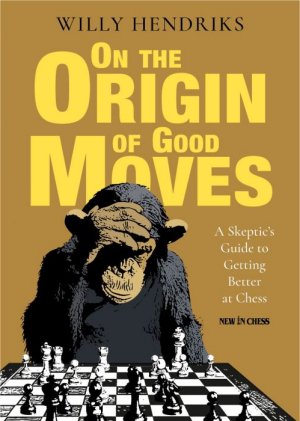
Willy Hendriks, On the Origin of Good Moves, New in Chess 2020
When I was learning chess, there was still a strong 'don't study openings, study the endgame' lobby but it has lost some of its power. Throughout chess history, studying openings was the main motor of progress. I said earlier that there has been no break in chess history (around Steinitz) but if I may mention a more symbolic break it is the 1834 match between De La Bourdonnais and McDonnell. These more or less strongest players of the time played a series of matches with more than 80 games in total against each other. Although they did not record their own games - that was not common practice at the time - the secretary of the London club who was present did so, thus adding enormously to what was already available in terms of recorded games. From this match onwards, scoring games became more common, more serious competitions came up and the amount of chess literature began to increase considerably. You could say that this match marked the starting point of chess as an empirical science, where theory and testing in practice began to mutually reinforce each other. The era of modern chess had been ushered in!
The starting point of On the Origin of Good Moves was an examination of the popular notion that 'the development of the chess-playing individual reflects the historical development of chess'. I think that applies well to the opening study. Throughout history, the study of openings, their application in games and the search by white and black players for improvements has led us to a better understanding of the value of different openings and positions, while at the same time constantly leading us to new types of positions. Thus, in a very evolutionary way, our understanding of the game has grown. In the same way, it is also a very fruitful way for the individual to study chess, especially nowadays with the Internet possibilities, where you can very productively combine the opening study with practice and receive feedback from that for further study.
When you compare the chess world at the time of Zukertort and Steinitz and the chess they played back then to modern chess – what is different, what remains the same?
In many ways, that era was already very similar to ours, the kind of people who played chess and how seriously they took it. But, for instance, competitive chess was still in full development, searching for the best tournament formulas, the right thinking time (and how to measure it) and more things like that. For a long time, analysing adjourned positions was considered unsporting and was also forbidden. Some also thought preparing for the opponent was something that actually did not suit a true gentleman. Playing with odds was very common, which has since died out completely. Problem chess occupied a very important place in chess magazines. In short, a world with many peculiarities but already populated with our kind of people.
The chess of the 19th century sometimes strikes us as somewhat strange because of the large number of King's gambits and Evans gambits and the somewhat typical position types that often result from them. But by the time of Steinitz and Zukertort, those openings were already starting to lose popularity, and one of the merits of the 19th century is that people found out empirically, by trial and error, that those two gambits are not the best way to open a game after all. Incidentally, that also puts into question the cliché romantic image of 'attack at all costs' because the theorists and players worked as hard for the defence as for the attack.
In that first World Championship match, both gambits therefore did not appear, much to the disappointment of a large part of the chess audience, which found it hard to understand that Steinitz and Zukertort had already taken a step further in chess development.
You looked at hundreds of games by Zukertort and Steinitz. Do you have a favourite Zukertort-game and a favourite Steinitz game?
Steinitz liked to leave his king in the centre, because after all it could take good care of his own safety, so to tease him a little posthumously I choose a game in which he himself demonstrated the dangers of that. In this case, that is not his most famous game, against Curt von Bardeleben from Hastings 1895, in which he managed to do just that, but the little-known game against Gustav Neumann from Baden-Baden 1870. In it, Steinitz sacrifices a piece for attacking that king in the centre and what I particularly admire is the patience with which he then plays on.
From Zukertort I do choose his most famous game, against Blackburne from London 1883, mainly because it nicely supports his claim that he had reconciled the old and the new school: a calm queen's pawn opening, then gaining a big positional advantage and, finally, refuting Blackburne's somewhat wild defensive attempt with a brilliant attack.
I think all your three books, "Move First, Think Later", "On the Origin of Good Moves" and "The Ink War" are instructive, thought-provoking and a joy to read. But what gave you the greatest pleasure when writing "The Ink War"?
Thank you for the compliment!
What I like to achieve is to bring chess to life, preferably with a nice (and short) chess fragment, supplemented with an interesting piece of text from that time or a funny anecdote, which also fits nicely into the main line of the story. With the reader lazily leaning back on the sofa in mind. If I find something interesting in an old chess magazine and manage to find a remarkable chess fragment with it, I feel a kind of detective-like happiness.
A find that made me very happy is on page 190. It comes from Zukertort's (and Hoffer's) magazine the Chess-Monthly and is about the 1882 Berlin tournament. Johannes Minckwitz, an old enemy of Zukertort from his Berlin period, had complained in his own magazine about the 'Sitzfleisch' of the English participants in that tournament, which he said was the reason why they outplayed the German participants there. I then found a letter to the editor from one 'Philidor Jones' in the Chess-Monthly, making fun of Minckwitz and his lament. I suspect that Zukertort himself, under a pseudonym, had sent that letter to his own magazine.
Funny thing is that in that whole tournament, there is actually only one game to be found where a participant from England, with the help of 'Sitzfleisch', outplayed his opponent: Zukertort-Minckwitz, 103 moves, 1-0! Next, I also saw that there was something very funny at the end of that game and that made me completely happy. Below is the snippet in question.
Sitzfleisch
The topic of concentration also emerged in a 'letter to the editor' in The Chess-Monthly. The writer, 'Philidor Jones', had come across an article in the Deutsche Schachzeitung by Minckwitz, who too had taken part in the Berlin tournament. In that article, Minckwitz, the enemy of Zukertort in his Berlin years, had tried to explain the success of the London chess players in Berlin.
'Gentlemen, Will you permit me to call the attention of your readers to a recent discovery in the physiology of Chess, which, I venture to predict, will cause its author to be ranked by posterity among the galaxy of Darwins, Haeckels, and Pasteurs of the present age. It is due to Herr Minckwitz, editor of the Deutsche Schachzeitung, and is nothing less than a solution of the great question, 'What is the cause of superiority in Chess?' [...] Mr. Minckwitz was grappling with this problem upon the true scientific basis of induction: Why had he and the champions of Berlin and Detmold been beaten by the London visitors at the recent Congress? And his solution, you must admit, in its grand simplicity, bears the stamp of scientific truth upon its face. His weighty words must be quoted in the original. "German players,'' he says, "could only await defeat when opposed …. zu den mit mehr Sitzfleisch ausgestatteten fremdländischen Schachfechtern." Indeed, our imperfect scientific terminology makes it rather difficult to render the word perspicuously, but the great discoverer means that valuable portion of the human frame which has to play, in all sedentary games, the most constant and least prominent of parts. It is Sitzfleisch that decides a game.'
In the days before the invention of the chess clock and the limitation of thinking time, the term 'Sitzkrieg' was sometimes used for the somewhat unsportsmanlike habit of thinking for so long that the opponent, due to fatigue or irritation, lost track. In the meantime, all serious tournaments were played with the clock, so Minckwitz's complaint seems to be more about prolonged playing on in a (more or less) equal position. However, if we look at the games of the London representatives, there are hardly any games in which the opponent went down because of extensive milking. Or it must be the following one: Zukertort-Minckwitz, 103 moves, 1-0! By the way, it was absolutely right that Zukertort tried to win that game. It was a very difficult ending, with a lot of material for a queen that was constantly threatening to give perpetual check. The finish will certainly have contributed to Minckwitz's annoyance.
Johannes Zukertort - Johannes Minckwitz
Berlin (6) 1881
Black has just captured a pawn on b4 and maybe he thought he had secured the draw with that. Zukertort proceeded with 90.Be7+ and Minckwitz must have anticipated this because it seems that 90...Qxe7 is now sufficient, after 91.Rxe7 Kxe7 Black’s king will reach the a-pawns in time. However after the clever 91.Ng6+! Kxg7 92.Nxe7, it was the knight who was just one step faster.
Not many readers of the Chess Monthly will have read the German chess magazine, so it cannot be excluded that it was Zukertort himself who wrote this letter to his own magazine. In those days, it was common in (chess) magazines and columns to publish letters or even articles under pseudonyms. However, this also made it possible for a columnist to produce letters himself and to present them as coming from real readers. If you had become embroiled in a polemic, this was a suitable tool for you, as a writer, to suggest approval from your readers or to bring up things that you could not say yourself. Conscientious authors, of course, did not indulge in this practice, although the above case seems fairly harmless, since most readers will have had some idea of who was behind 'Philidor Jones'.
Another remarkable thing about Minckwitz's complaint is that one would not think of Zukertort at all in connection with 'Sitzfleisch'. From all descriptions, he emerges as someone who played fast, stood up when he was not to move and often walked around in a nervous and impatient manner. In that respect he could learn something from his great rival Steinitz, who really had Sitzfleisch at his disposal.
Thank you for your time and your insights!
Links
